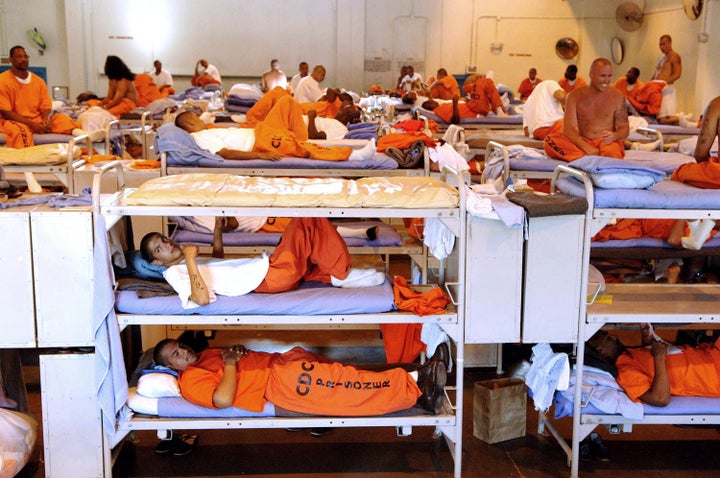
NEW YORK -- Since 1977, California’s prison system, one of the most punitive in the country, has been built on the belief that a man like Shawn Vasquez doesn’t--in fact, cannot--exist.
Vasquez grew up on the streets of Oakland, spending his days searching for abandoned houses where he and his drug-using mother and younger brother could spend the night in safety. He dropped out of school in sixth grade to care for his mother, supporting the family by selling drugs and rising through the ranks of Oakland’s gang scene until he became the leader of one of the fiercest groups, Ghost Town Gang. When he wasn’t on the streets, he cycled in and out of prison, starting with the juvenile system at nine years old and finally landing himself in federal prison for seven years on murder charges.
"I put myself in that predicament because I was Bossman once upon a time," Vasquez said, while denying his connection to the murders. "I gave no choice to the people who were saying that they needed to get this individual off the streets."
As one of more than 160,000 inmates in California during the early 2000s, Vasquez was unremarkable. Except, perhaps, for the extreme violence in his story.
Now 39 years old, drug-free and supporting his wife and family by working for a nonprofit that helps ex-cons reenter society, Vasquez serves as an example of what three decades of California politicians have denied was possible: rehabilitation. The pinnacle of his life, said Vasquez, was testifying at the Assembly Select Committee on Re-entry last week. There, he spoke to legislators the same way he does each day at work when he talks to ex-cons struggling to navigate a system that seems stacked against them.
"I don’t go in with a speech because I can’t spell everything," he said. "I just speak from my heart."
Monday’s Supreme Court ruling that California’s overcrowded prison system constituted cruel and unusual punishment has shined a light on the state’s 30-year legislative history of being tough on crime, a political game in which both prisoners and taxpayers lost. The California prison system has the highest recidivism rate, the least effective rehabilitation program and the highest cost for taxpayers of any in the nation. The state violent crime rate, meanwhile, has plummeted since its peak in the early 1990s but has stubbornly remained above the national average.
Each year, approximately 70 percent of California’s prisoners, more than 100,000 people, become free men and women. But within months, nearly half end up behind bars again, usually for having flunked parole, which, until last year, was mandatory for every ex-con. These nearly 50,000 men and women head back to jail for 30 days to up to a year, leave, maybe return, leave again. Each prisoner costs the state $53,000 a year.
"It’s a hugely fast revolving door--faster than in any other state," said Joan Petersilia, the faculty co-director of the Stanford Criminal Justice Center.
In 1977, California lawmakers passed legislation that shifted sentences from indeterminate, meaning a parole board decided the length of jail time depending on the case, to determinate, meaning inmates served a fixed sentence. California was the second state in the nation to make this change as a result of a rare political alliance between liberals, who argued that indeterminate sentencing was racist, and conservatives, who argued that all sentences should be longer to deter against crime.
Determinate sentencing allowed the state legislature to seize control of deciding how long criminals served, and prison time quickly became a hot button political issue.
"California’s elected officials pandered to the public’s fear of violent crime, campaigning and voting for some of the most punitive sentencing laws in the nation," said Malcolm Young, director of Northwestern University School of Law’s Bluhm Legal Clinic’s Program for Prison Reentry Strategies.
Over the next three decades, California passed hundreds of laws that increased prison terms. One of the most significant was the 1977 policy dictating that every prisoner leaving the system got paroled. By the mid-2000s, California sent 50,000 to 70,000 ex-cons back to jail each year for minor parole violations such as missing a monthly meeting, failing a drug test or forgetting to update their officer about a change of address. Each return jail stint cost taxpayers between $4,000 and $50,000.
The controversial three-strike policy, passed in 1994, immediately funneled tens of thousands more ex-cons back into the system, sometimes for offenses as minor as stealing golf clubs from a posh country club or swiping $153 of children’s tapes from Kmart. Dozens of states adopted three-strike policies during the mid-1990s, but California also added an additional two-strike provision that sent past offenders to jail when they would have gotten probation.
"It was a double whammy," said Petersilia. "The three strikes law is hugely important to California's prison crowding problem."
As the tough-on-crime laws piled up, so did the inmates' triple-level bunk beds. A system that was built to house 80,000 inmates swelled to a peak of 173,000. Crime rates dropped, but not in lockstep with increases in prison population. For example, both the state’s crime rates and the number of inmates have dropped significantly in the last three years.
"People said we passed three strikes, we got tough on crime, and the rates are low. But that’s not the story," said Barry Krisberg, director of research and policy at the Institute on Law and Social Policy at the University of California, Berkeley School of Law.
Krisberg points to the opposite trajectory of the state’s juvenile prison system as evidence that being tough on criminals doesn’t decrease crime. In 1996, California had 10,000 juveniles locked up in state prisons; today there are only 1,000. As the number of underage inmates shrunk, mainly due to political pressure to treat kids more sympathetically, so did juvenile crime rates.
"Fundamentally, what I would think is one of the big issues here is the psychological thing: We still believe that kids can be redeemed, but our attitude toward adults is much harsher," said Krisberg, who said that many of the reforms on the juvenile side would work for the adult system.
Recently, California has been toying with more lenient legislation due to the sustained federal pressure that culminated in Monday’s ruling. Last year’s shift in parole laws, which allowed some non-violent offenders to sidestep parole and others to avoid getting sent back to jail for minor violations, was a first step for prison reform advocates. Currently, Governor Jerry Brown is pushing a more ambitious parole realignment plan that would shift tens of thousands of non-violent offenders from the state system and into county prisons. The legislation is expected to be on the voter ballot on the fall.
Some community leaders insist that sentencing reforms alone aren’t enough to lower the 70 percent recidivism rate. What’s needed is a support network for inmates reentering society, say advocates like Reverend Eugene Williams, director of Regional Congregations and Neighborhood Organizations, a national faith-based community organization.
"We can’t repair a shredded safety net on volunteers alone," said Williams. Inside prison, California inmates have fewest educational or skill-based opportunities of any prisoners in the nation. On the outside, a slashed state budget makes drug-treatment and counseling programs just as scarce, and ex-cons are often ineligible for state-run programs.
"Our public policy in this country is to punish offenders forever," said Williams.
But for the minority of ex-cons in California that do succeed, the turnaround is tremendous.
“I have people coming up to me, people that I used to get into it with, and they just cry, saying, 'Is that really you?'" Vasquez said. "One man walked up to me and said, 'Are you really the infamous Bossman?' And I said, 'Yeah, we’re about to go do some outreach, do you want to come?'"
